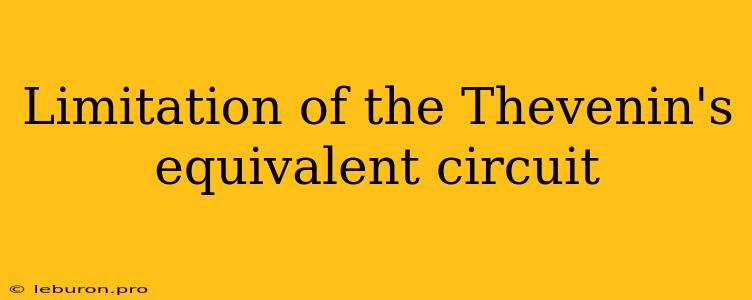Thevenin's theorem, a cornerstone of circuit analysis, provides a powerful tool for simplifying complex circuits. It allows us to represent any linear circuit with a single voltage source (Thevenin voltage, $V_{TH}$) in series with a single resistor (Thevenin resistance, $R_{TH}$). This simplification can significantly reduce the complexity of circuit analysis, making it easier to calculate currents and voltages. However, despite its widespread application, Thevenin's equivalent circuit has limitations that need to be acknowledged.
Limitations of Thevenin's Equivalent Circuit
Nonlinear Circuits
Thevenin's theorem is fundamentally based on the principles of linearity. It relies on the fact that the superposition principle holds, which implies that the response of a linear circuit to multiple inputs is the sum of responses to each input acting individually. Therefore, Thevenin's equivalent circuit cannot be applied to circuits containing non-linear elements such as diodes, transistors, or operational amplifiers. These components exhibit characteristics that do not follow a linear relationship between voltage and current.
Time-Varying Circuits
Thevenin's equivalent circuit is applicable to circuits with constant voltage and current sources. However, when dealing with time-varying circuits, such as circuits driven by sinusoidal sources or circuits with capacitors and inductors, the equivalent circuit may not be valid. This is because the behavior of capacitors and inductors is dependent on the frequency of the applied signal, and the equivalent circuit derived at a specific frequency may not be accurate for other frequencies.
Dependent Sources
Thevenin's theorem is limited to circuits with independent sources. A dependent source's output voltage or current is dependent on another voltage or current in the circuit. When dependent sources are present, the equivalent circuit becomes more complex, and the standard Thevenin's method may not be readily applicable. The presence of dependent sources necessitates a more sophisticated approach to circuit analysis, often involving techniques like nodal or mesh analysis.
Non-Uniqueness
While Thevenin's equivalent circuit simplifies circuit analysis, it's important to remember that the equivalent circuit is not unique. Multiple Thevenin equivalent circuits can be derived for the same original circuit. This non-uniqueness arises from the fact that the equivalent circuit is only valid when viewed from specific terminals. Changing the terminals of interest can result in a different equivalent circuit.
Power Dissipation
One of the limitations of Thevenin's equivalent circuit is its inability to accurately represent the power dissipation in the original circuit. This is because the equivalent circuit only provides information about the terminal voltage and current. The internal power dissipation within the original circuit is not reflected in the equivalent circuit.
Practical Considerations
While Thevenin's equivalent circuit is a powerful tool for circuit analysis, it's important to consider its limitations in practical applications.
-
Internal Resistance of Sources: Real voltage sources have internal resistance, which is not considered in the ideal Thevenin model. This internal resistance can significantly impact the performance of the circuit, especially when dealing with high current loads.
-
Accuracy of Measurements: The accuracy of the equivalent circuit depends on the accuracy of the measurements of the Thevenin voltage and resistance. Any errors in these measurements can lead to inaccuracies in the analysis.
-
Complexity of Circuits: Thevenin's theorem is most effective for relatively simple circuits. For complex circuits with multiple sources and loads, the process of deriving the equivalent circuit can become cumbersome.
Conclusion
Thevenin's equivalent circuit is a valuable tool for simplifying circuit analysis and understanding the behavior of linear circuits. However, it is crucial to be aware of its limitations. Non-linear elements, time-varying circuits, dependent sources, and non-uniqueness of the equivalent circuit are factors that may necessitate alternative analysis techniques. Additionally, practical considerations such as internal resistance and measurement errors should be acknowledged when applying Thevenin's equivalent circuit to real-world applications.
